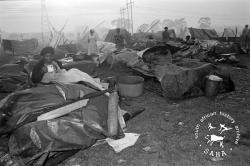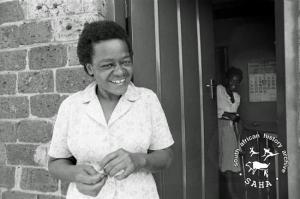Tembisa was established on a farm originally owned by Mr. J.H.M. Meyer and Mrs M.W.Z. van Wyk. After negotiations between the purchasing committee [and the owners] ... the land was purchased at R3, 52 per hectare with funding from the National Housing Commission and government loans.
To implement its separate development policy, the government began to remove black people from the ‘white' areas to Tembisa. Mrs Thulare, whose family lived in Dindela, remembers that they were forcibly removed to make way for an industrial area:
"There was a time when they told [our parents] that they have to move, because the place that they were in was supposed to be used for industries. That's when they built this place called Tembisa. They moved us in that manner because they were not begging us and they didn't care whether you have fixed your house or not ... You were supposed to move and take all your belongings. They didn't care if they broke them or what. The only thing that mattered is that you have moved to where they thought you were supposed to be. Tembisa started in sections."
Simon Ramogale, who was from Pietersburg and occasionally stayed with his uncle in Olifantsfontein during school holidays, explains the meaning behind the names of each section:
"I was born in Pietersburg. I left Pietersburg when I was coming to a boarding school in Middelburg. But then my uncle was staying in Olifantsfontein. So by the time I was staying [with him, my friends and I] would go to where Tembisa is now. [There were] lots of fields. We used to go there and buy mielies [maize] for cooking.There were farms there. That is why you could see in Tembisa [the sections] have those kind of farming names. You see where they call Sedibeng and Tsepo sections, that's where there were lots of wells for the boreholes for the farmers; you cross slightly up, they say [it is] Mashimong section.
"That's actually where the fields were. Then you go to Sethokga section. You see, Sethokga means lots of forests. [In] Moriting section, there were shades [because of the many trees there]. We could sit under the tress. That's where all these names come from.To lure people to Tembisa, the government built a handful of beautiful and attractive houses that could be seen by people travelling in train that passed next to Tembisa. Timothy Mabena believes this was to create an impression that all the houses in the township were as attractive as those houses."- Simon Ramogale1
Recalling this ploy, Mr Julius Lelaka remarks:
"You see, my father wanted a bigger house. You see, when you are at Oakmoor Station the first line of houses it were the five-roomed houses and very nice houses. The thing is, those five-roomed houses were meant for people in a train passing Tembisa that they should think that people who were living there were living a nice life."
 Although there seems to have been disparities in housing in Tembisa, for some of the residents of the old locations the removals were a welcome relief, because of the hardships they experienced living in these locations. Rosina Marakalala, who was born at Ga-Mapila (Limpopo Province) in 1933, and had arrived in Johannesburg in 1956, remembers that when she arrived in the Rand she initially lived with her husband in Primrose, Germiston, where he was working.
Although there seems to have been disparities in housing in Tembisa, for some of the residents of the old locations the removals were a welcome relief, because of the hardships they experienced living in these locations. Rosina Marakalala, who was born at Ga-Mapila (Limpopo Province) in 1933, and had arrived in Johannesburg in 1956, remembers that when she arrived in the Rand she initially lived with her husband in Primrose, Germiston, where he was working.
After her husband found another job in Edenvale they moved to Dindela Location. She was disgruntled by the living conditions at Dindela Location.
In her own words:
"And from there [Germiston] I went to Edenvale. But I didn't stay for a long time. I stayed for about two years. [Life there] was painful, because sometimes in the street you would see water flowing. Toilets that we had were bucket system. When they came to take them they would just empty them there in front [of us] ... Life was not good. And the Boers were harassing us looking for pomets (residential permits) at night ... It were shacks and we were renting there. And then they moved us from there ... with trucks and [they] brought us here in Tembisa. And when we got here it was also shacks, but then they built us four roomed houses."
Some of the residents were removed from Alexandra Township, north of Johannesburg. The government had intended to convert the township into a hostel complex comprised of residents working in the northern suburbs. Some of those removed were settled in parts of Soweto, and others were brought to Tembisa. Lazarus Mawela, whose family was amongst the first to be removed from Alexandra to Tembisa, remembers that his father, who was a member of the South African Police, preferred Tembisa to Soweto because Soweto had a negative reputation as a crime-infested area.
He remarks:
"...before we were moved to Tembisa, my parents were allocated a house in Meadowlands, Soweto. But my dad, who was a policeman, felt that he doesn't want to go to Soweto because of the situation in the township. During those days you would read in the second page of The World and it would say ‘at least 21 people were killed this weekend'. It was very rough. So he said ‘I'm not going there'."
For the Mawela family, moving to Tembisa also provided them with a sense of ownership and belonging.
Lazarus Mawela explains:
"I was born in Alexandra Township in 1957. We lived at Fifth Avenue, next to the men's hostel. We were then moved to Tembisa in October 1969. The government provided transport - you know, those GG (General Government) trucks. You had to make sure that you've packed your belongings in boxes the night before. In the morning when the trucks arrive they just load your stuff, furniture. When we arrived in Tembisa we were placed in Kgatlamping section. It was a good thing because now you could have your own garden instruments - spade, rake - and even your own territory. You could start planting lawn and trees. These were some of the things we would not have in Alexandra."
At this stage the National Party was concerned with limiting the influx of black people in the urban areas (they had to remain in the reserves which were later turned into bantustans/homelands) and to break the unity amongst the blacks demonstrated during the Defiance Campaign in 1952. It therefore ruled that the new townships should be divided according ethnic lines. For example, AmaZulu were to be allocated their own section, so were AmaXhosa, and Bapedi, and Batswana, and Basotho.
 The Germiston City Council, which was responsible for the administration of Tembisa Township, implemented the government's policy of ethnic division with vigour by settling people in Tembisa on ethnic lines.
The Germiston City Council, which was responsible for the administration of Tembisa Township, implemented the government's policy of ethnic division with vigour by settling people in Tembisa on ethnic lines.
Mrs Thulare remembers:
"We were divided according to our racial [sic] groups ...You see, Caleni was a place for the Zuluspeaking people and the Xhosa's. And then there is Xubeni and that was a place for Tsonga people. And then Sedibeng, that was for the Sothos."
Similarly, Mr David Malabela adds:
"If you could look clearly, all the sections of Tembisa were divided according to the languages that people spoke. At Maokeng, Tshepo, Tsenolong, Makhulong, Sedibeng and Meriting were sections where all the Pedi speaking people lived. And Mthambeka, Xubeni, Emfihlweni, Ndulwini and Khalambazo were the places where the Zulu-speaking people lived. The Tsongaspeaking residents were staying at Isithame."
This policy caused tensions between the residents of Tembisa.
Micheal Figo Madlala explains:
"I remember I was very small, you know, if you were going to Jan Lubbe [stadium] - it was not Jan Lubbe at that time, it was Ground Number One - that's what we used to call it... If you were going there, passing through Mashemong [section] they would say, ‘"here comes lekwapa' (i.e. a foreigner) and they would chase you. I used to study in the Shangaans' section, so when schools were closing they'd [chase] us ... And the same applies to a Sotho person who'd be found around there would be chased ... So it was like that. Whether people were consciously thinking about those things or not, but they were there. So that was the nature of how things used to be. When I grew up I witnessed some of those things In a similar vein."
- Michael Figo Madlala 2
Malabela recalls:
"They will tell you, ‘We do this to you because you are not staying here. Next time you will learn to stay in your place'."
Notwithstanding the crippling impact this policy had on the unity of blacks created over many years in the old locations, it however turned out to be a temporary inconvenience. Sports and schools' musical competitions brought together young people from different ethnic backgrounds.
Timothy Mabena explains:
"Although schools were divided on ethnic bases, but sports brought students together. As students we knew who in the whole of Tembisa schools was the best in athletics - who could outrun all the students in different schools. Similarly, when it came to music we knew which school was the best. There were school choir competitions from lower to higher primaries. The best school would win a trophy. So, when we arrived at high school we already knew each other. Besides inside the township we belonged to various soccer teams. These soccer teams were divided by sections. [But] some of the teams had people from different ethnic backgrounds. It was for that reason that some of the residents of the township were able to speak different languages."
NEXT: The quiescent & prosperous 1960s
1. Interview with Simon Ramogale, conducted by Tshepo Moloi, Johannesburg, 7 April; 18 August 2004; All the names referred to by Simon Ramogale have been translated from Sesotho to English.
2. Interview with Mike “Figo” Madlala by Tshepo Moloi, for the South African Democracy Education Trust (hereafter SADET) Oral History Project, Kempton Park, 7 September 2004.



